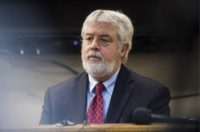The 100 design firms in ENR Midwest’s Top Design Firms ranking are offering more expertise and services across the 11-state region. That diversification resulted in another year of growth as the firms reported total revenue of $5.78 billion for fiscal year 2018—an increase from the $5.67 billion reported by the top 100 firms that responded to last year’s survey. It is also an increase from the $4.9 billion reported for fiscal year 2016, the first year that ENR Midwest’s coverage expanded to include all Midwestern states.
While giants such as AECOM and Burns & McDonnell once again fought it out for the top spot on the list, the entire ranking shows architects and engineers delivering everything from rail, airport and transit designs to skyscrapers and energy plants. Wiss, Janney, Elstner Associates (No. 40 this year, up from No. 43 in 2018) considers itself a problem-solving firm, and its revenue grew at a pace similar to that seen by many of the region’s design architects and engineers.
Northbrook, Ill.-based WJE specializes in the investigation, analysis, testing and design of repairs for historic and contemporary buildings and structures. Gary Klein, WJE executive vice president and senior principal, said that while clients kept calling steadily for WJE’s services, even during the recession, the firm was able to track an uptick in more proactive problem-solving contacts.
|
Related Link |
“One of the things we track is the reasons clients call us,” Klein says. “We try to categorize those into primary areas. Primarily, clients call us to solve a construction problem, but, increasingly, they have been calling us to avoid a problem. For example, peer review services. That was a very small part of our work a couple of decades ago, but it is now very substantial. [Clients are] looking to hire us in advance to review their designs instead of hiring us after the building leaks or the stone fails.”
The frequency of those calls stabilized, and in the last year, the number of clients calling WJE to solve their problems increased, Klein says.
One of the things that has helped WJE better serve all its clients is the completion of the Janney Technical Center on its Northbrook Campus last year. The 70,000-sq-ft testing and applied research facility includes an array of chemistry, petrography, metallurgy, concrete and mortar, corrosion and structural testing laboratories as well as environmental exposure chambers. Klein says that while WJE provided these services previously, having all these capabilities under one roof has helped the firm better apply its expertise.
“[It] replaces older facilities and capabilities that we’ve had,” Klein says. “It’s huge because we can look at everything from construction materials at their chemical and elemental levels to full-scale testing of bridge girders. But I would be remiss if I didn’t say the facilities are one thing, but having people that have the experience to know when to test, how to test and make sense out of the results is the most important thing.”
At fourth place this year is Stantec, which had some of the strongest revenue performance across its 30 offices in all of the Midwest states. The architecture and engineering firm also had some of the most diverse projects, with everything from student housing at Western Michigan University to a campus redevelopment near Chicago’s Wrigley Field and even stormwater diversion tunnels.
“We do quite a bit of work with buildings and community development in states that we don’t have a strong presence in already,” explains Elie Sabbagh, Stantec vice president. “That’s how we kind of get our foot in the door. For higher education, most of the time you don’t need to be local for that work. The same thing goes for community development. We’re winning projects, and we use our colleagues across the country.”
The firm’s Boston office, for example, has completed work in Dayton, Ohio, where Stantec has won several planning projects.
“The same kind of concept goes for the states that we’re trying to establish a better presence in,” Sabbagh says. “We progress in the conversation. We’re always trying to get into newer markets in Omaha, Iowa and Kansas, and expand there.”
Stantec also relies on expertise at its various regional offices. The firm’s Kansas offices provide water and environmental design services as well as landscape architecture. Meanwhile, in Illinois, the higher education group assists in nearby Michigan.
“We’ve got a pretty strong student housing program across the country,” says Michael Toolis, vice president and regional business leader for Stantec’s Chicago architecture office. “[The WMU] project probably represents the most recent changes to where it’s almost like you’re building apartments for the kids, as opposed to the old, more traditional campus living options.”
Chicago architect Solomon Cordwell Buenz moved up to No. 53 on the Top Design Firms list this year from No. 59 last year due mostly to major urban skyscraper projects such as Chicago’s Tribune Tower redevelopment. One thing that Chris Pemberton, SCB president, has noticed is that both urban high-rise residential and office projects have changed considerably in just the last two years.
“The range of what constitutes ‘mixed use’ has gotten broader,” Pemberton says. “For a long time, you might have had a residential multifamily apartment tower with a little bit of retail and parking, but now you’re very commonly mixing in hotel and office—sometimes all three together. Sometimes you might have a hotel and residential. Interestingly, we’re seeing a lot of projects with a mix of office and residential.”
Pemberton noted that SCB’s urban work has significantly expanded from the big cities, such as Chicago, where it has worked for decades, to developments on prime sites in downtown areas in cities such as Des Moines and Nashville.
Pemberton says SCB is seeing growth in demand for design services as well as an increase in the number of cities looking for those services,“which we think is fantastic.”







